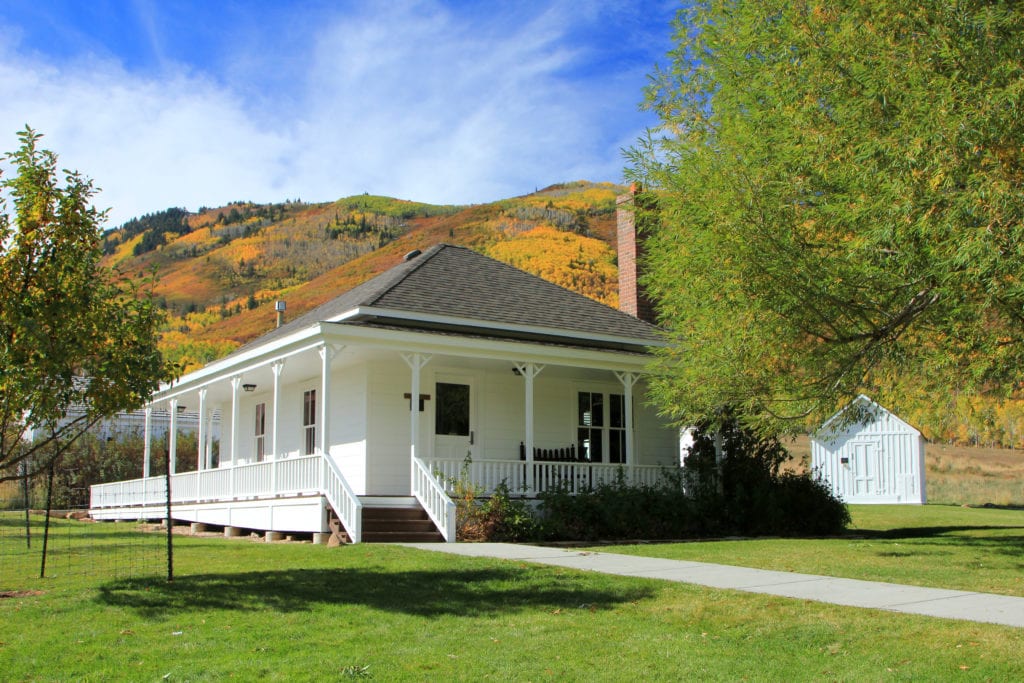What are USDA Loans and Do I Qualify?

If you’re moving to a small town or rural area and plan on buying a house, it’s important to explore your mortgage options — including USDA loans. USDA loans come with many benefits, like no down payment, flexible eligibility requirements, and low interest rates. However, they won’t be a good fit for everyone. Read on to learn about the ins and outs of USDA loan requirements so you can figure out if they’re the right fit for you.
What USDA loan programs are
U.S. Department of Agriculture developed the USDA loan program to help more people afford homeownership while simultaneously developing smaller, rural communities. It offers zero-down home loans with low interest rates to qualifying homebuyers who are moving to towns with less than 20,000 people (in most cases).
To qualify, an individual or family needs to earn a low-to-moderate-income that doesn’t exceed the limits for their area. There are also USDA loan programs that help qualifying homeowners repair or upgrade their homes and bring them up to code.
Understanding how USDA home loans work
There are three different types of USDA loans that you may qualify for, depending on your needs and income level: guaranteed, direct, and home repair.
Guaranteed loans
USDA guaranteed loans are zero-down mortgages that are issued by private lenders and backed by the USDA. They’re available to buyers in rural and suburban areas who have low-to-moderate income. Guaranteed loans are offered at a 30-year fixed rate. In order to qualify for a guaranteed loan, your adjusted household income can’t exceed 115% of the median household income.
Direct loans
Section 502 direct loans are zero-down mortgages that are issued by the USDA instead of private lenders. They have interest rates as low as 1% with subsidies and terms between 33 and 38 years. Direct loans are best for very low-income buyers because they have strict income restrictions. Your household income can’t exceed 80% of the median income for your area to qualify for this loan.
Home repair loans
Home repair loans are designed to help low-income homeowners make necessary repairs to their homes. Your family income must be below 50% of the of the area median income to qualify for this loan. If you’re eligible, you’ll be able to get a loan of up to $20,000 at a fixed interest rate of just 1%. You’ll also have up to 20 years for repayment.
USDA eligibility: How to know if you qualify
Every buyer has to meet the USDA loan requirements in order to be eligible for the program.
To be eligible, you must:
- Be a U.S. citizen or permanent resident
- Use the home they plan to buy or repair as a primary residence
- Purchase or own a home in a qualifying rural or suburban area
- Meet the income eligibility requirements for the loan type they’ve chosen
- Be able to prove that you have a stable and dependable income
- Be able and willing to pay back the loan on time
In addition to meeting these basic eligibility criteria, buyers must also meet the credit score requirements set by their lender.
More about credit requirements for a USDA loan
The USDA doesn’t have minimum credit score requirements for its loans. However, many lenders require you to have a credit score of 640 or higher. You’ll also need a good credit score to qualify for a loan through the USDA’s automated underwriting system, which is the fastest way to get approved.
If you have a credit score below 640 or minimal credit history, you may still be able to get a USDA home loan. Instead of going through the automated underwriting system, your application will be evaluated by hand. Your lender may ask you for alternate sources of credit — like proof of rent or utility payments — to prove that you can pay bills on time and handle a mortgage.
In order to review your credit, your lender will need:
- Your credit score and report: Your lender will pull your credit report to view your payment history and outstanding debt. This will help them determine how you have managed debts in the past, which is a predictor of how you will handle the mortgage.
- Alternate sources of credit: If you have little-to-no credit history or a few bad marks, you may also need to provide alternate sources of credit — like rent, cable, or insurance payments — to prove that you’re reliable.
More about income requirements for a USDA loan
Each type of USDA loan has different income limits. To qualify for a guaranteed loan, for example, your adjusted household income can’t exceed 115% of your area’s median income. In most counties, that means you can’t earn more than $86,850 after deductions. The income limits for direct loans are even less. Your family’s adjusted income can’t exceed 80% of the median income for your area, which is as low as $25,000 in some areas of the country.
In order to qualify for a USDA loan, you’ll also have to prove that you can comfortably afford a mortgage. Your mortgage payments can’t exceed more than 29% of your monthly income if you have a very low income, or 33% if you have a low-to-moderate salary.
In order to determine if you meet the income requirements, your lender will look at the following:
- One or two years of tax returns and a few months of pay stubs: You’ll need to provide your lender with proof of income for everyone in your household. This will help the lender determine if you meet the USDA’s income requirements and can afford the loan.
- Proof of assets: You’ll need to provide proof of assets, like savings and investments to your lender. In some cases, your assets may be counted as part of your household income. They can also serve as a compensating factor if your credit score is below average, so it’s important to provide your lender with documentation of all of your assets.
- Proof of expenses: Lenders will also look at your adjusted income, which is what your household earns after qualifying expenses like childcare and medical expenses are deducted. Your lender will need to see a record of these expenses to calculate your income and determine your USDA eligibility.
How to apply for a USDA loan
Before you can apply for a USDA home loan, you’ll need to find a qualified lender. Here are some things to look for when shopping around:
- Expertise: A lender that specializes in USDA loans will understand the ins and outs of the program. They’ll be able to guide you through the process of securing the loan and answer all your questions along the way.
- Customer service: You should try to find a lender that provides top-notch customer service. Read online reviews and see what customers are saying about each lender you’re interested in working with.
- Rates: Ask each lender for a loan estimate (prequalification) and compare their interest rates and fees. You can use a mortgage calculator to see how different rates will impact your overall costs.
- Credit score requirements: If you have below-average credit, you should try to find lenders that have flexible credit score requirements.
Applying for a USDA loan, step by step:
Once you’ve identified the lender you want to work with, you can begin the process of applying for a USDA loan. Here’s an overview of the steps you’ll need to take to get approved.
- Step 1: Decide which loan is right for you: direct or guaranteed.
- Step 2: Apply for pre-approval with your lender. This will give you a clear idea of your price range and will give your bid more weight in the eyes of the seller.
- Step 3: Find a USDA-approved home.
- Step 4: Sign a purchase agreement.
- Step 5: Fill out the application and provide your lender with all the documentation they need, like proof of income and assets. Then your lender will review the loan application and send it to the USDA office for approval.
- Step 6: It usually takes a few weeks for your application to be approved. Once it is, you’ll finally be ready to close on your home.
Securing a USDA loan can be a lengthy process, but it’s worth it to be able to move into your dream home and save money in the long run.
USDA home loan pros and cons
Pros
- No down payment: Because USDA loans don’t require a down payment, you’ll be able to buy a home even if you don’t have much money saved.
- Flexible credit requirements: Many lenders require you to have a credit score of at least 640 in order to qualify for a USDA loan. However, some lenders will consider your application even if you have a lower score.
- Low interest rates: USDA loans tend to have lower interest rates than conventional mortgages. Lenders are often able to offer borrowers more competitive interest rates through the USDA loan program because the government backs the mortgages.
Cons
- Income limits: In order to qualify for this program, you can’t have more than low-to-moderate income.
- Primary residence requirements. USDA loans can’t be used to buy vacation homes or rental properties. They can only be used to purchase a primary residence that doesn’t produce any rental income.
- Area restrictions. If you want to purchase a home in a bigger city, USDA loans won’t be right for you. You can only use USDA loans to buy a primary residence in qualifying rural and suburban areas.
- Fees. When you close on your home, you’ll have to pay a guarantee fee, which is similar to private mortgage insurance (PMI). It typically equals 1% of the loan amount. You’ll also have to pay an annual fee each year, which costs around 0.35% of the loan balance. Unlike regular PMI, this fee doesn’t go away once you gain 20% equity and will need to be paid over the whole life of the loan.
- Time: A USDA loan can take more time to process than a conventional loan.
Although USDA loans have some drawbacks, they’re a good option for buyers looking for flexible approval requirements and no down payment.
Frequently asked questions about USDA loans
Thinking about getting a USDA home loan but still have concerns? Here are some answers to common questions.
What is the USDA loan income limit?
In most areas of the country, the income limit for a guaranteed USDA loan is $86,850 for a family of one to four and $114,650 for a family of five to eight. However, if you live in an expensive county, you may still be able to qualify for a USDA home loan with a higher household income. In Boulder, Colorado, for example, the income restriction for a family of one to four is $108,550 and rises to $143,300 for families of five to eight. For direct loans, the income limit is less, as it can’t exceed 80% of the median income for your area.
Who qualifies for a USDA home loan?
Both first-time and repeat homebuyers can qualify for a USDA loan as long as they meet certain USDA eligibility requirements.
What is the maximum amount buyers can borrow?
If you’re getting a direct home loan, you won’t be able to borrow more than the loan limit for your area, which is $265,400 in most counties. But if you qualify for a guaranteed loan, there’s no limit to how much you can borrow. You’ll just need to prove enough income to afford the loan.
Can I have two USDA loans at the same time?
Unfortunately, the USDA doesn’t allow borrowers to have two USDA loans. If you already own a home that’s financed by a USDA loan, you won’t be able to take out another loan until you sell it.



